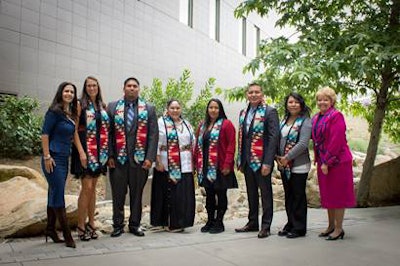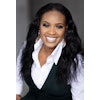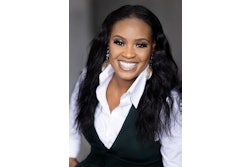 Graduating 2015 Native American students (Photo courtesy of California State University, San Marcos).
Graduating 2015 Native American students (Photo courtesy of California State University, San Marcos).When bringing up the topic of having Native American heritage, many people will typically say someone in the family, usually a grandmother or grandfather or great-grandmother/ grandfather, always claimed they are at least part Native American. U.S. Sen. Elizabeth Warren, D-Mass., for example, has said that she grew up with such stories in her own family.
According to a recent Pew Research Center study, 50 percent of people surveyed who claim a mixed heritage say their grandparents or parents are of non-Hispanic White and American Indian heritage.
“This is higher than what the U.S. Census data show,” says D’Vera Cohn, a senior writer and editor for the Pew Research Center. “The difference being that the census asks people to self-identify their own race, while our survey asked people to give the race of their parents and/or grandparents.”
Twenty-one percent of multiracial adults checked the non-Hispanic White/American Indian combination in the 2013 U.S. Census Bureau’s American Community Survey.
The difference may seem like comparing apples to apples, but while 50 percent of the people identified their parents or grandparents of being of Native American heritage, they didn’t identify themselves as being “multi-racial.” Only 25 percent of these same adults surveyed consider themselves multiracial.
In addition, 12 percent identify themselves as non-Hispanic Black and American Indian, while another 6 percent identify as non-Hispanic White, Black and American Indian. Another 11 percent identify as multiracial Hispanic.
Doctoral student Diana Hart’s birth certificate may identify her as “negro,” but she identifies herself as multiracial, based on family stories of being of mixed Black and Native American heritage. “My brother identifies as a Black man. My sister sort of identifies as a Black woman, but it isn’t easy for either of them,” Hart says.
Hart, who lives in Colorado, says that, based on family legend of Cherokee heritage, as well as her own research, she believes they are descended from the North Carolina branch of Saponi Indian.
“I have always felt I didn’t fit into the Black community because my parents did not teach me to be any culture at all,” Hart says.
“Instead, I have had to figure out where I fit. When I saw a Saponi woman on the website who looked like she could be my twin, and when I talked to a Saponi male whom I sent my picture to, it confirmed I am Saponi.”
Sharon Chayra, a CEO based in Las Vegas, says that she grew up believing she was of Hispanic descent. She now feels that her grandfather may have said that in order to obtain employment. Chayra says that she grew up feeling different from the children around her.
“A teacher once told my mom I looked and acted just like the kids he taught on the reservation,” says Chayra.
Chayra says she is not enrolled in any of the Apache or Yaqui tribes; her father’s cousins, who spell their surname slightly different, are. “In retrospect, I realize I was raised largely in the American Indian way and I am accepted by other Native friends who are enrolled.”
The year of self-identification
If 2015 could be summed up in terms of diversity, it might be dubbed the “Year of Self-Identification” or maybe dubbed the “Year Self-Identification Came into Question.”
Rachel Dolezal, the former head of the Spokane NAACP in Washington state, made headlines this past summer when her parents went on television to reveal that their daughter is, in fact, White. Dolezal had apparently altered her appearance as well as claimed a Black man as her father. Dolezal, whose parents adopted Black children and who has biracial children with a Black man, said that she’s always identified as Black, drawing herself as a child with a brown crayon and attending Howard University.
About that same time this summer, Terry Lee Whetstone was charged (and later pleaded guilty) to claiming to be Native American and profiting from art he sold as a Native American artist.
Whetstone has been selling his art for more than 30 years, but the federal government alleged that Whetstone violated the 1990 Indian Arts & Crafts Act, which prevents people who are not enrolled in a federally recognized tribe from claiming their art is Indian made.
According to the Indian Arts and Crafts Board, people who falsely claim to be Native Americans to sell art “undermine the market for authentic Indian art and craftwork and severely undercut Indian economies, self-determination, cultural heritage and the future of an original American treasure.”
Whetstone is an enrolled member of the Northern Cherokee Nation but is not enrolled in any one of the three federally recognized Cherokee tribes. There are 567 federally recognized Native American tribes in the United States.
Accuracy in numbers
Dr. Joely Proudfit is director of the California Indian Culture and Sovereignty Center and department coordinator of American Indian studies at California State University, San Marcos. The college is one of the few universities in the United States that reports a high number of Native American students. Proud t says that legal recognitions are the one big difference between Native Americans and any other ethnic group.
“That big difference is that we’re a political group,” she notes. “To legally state that you’re an American Indian, you must prove that you are and we do that through tribal enrollment.”
Proudfit acknowledges that there are problems in centuries-old recordkeeping and familial folklore that could have been embellished throughout the years.
“I think there are a few things going on with people who identify themselves as American Indian,” she says. “These surveys and studies include people who are taking word from family folklore and there are some people who just identify with this imagination of a hero Indian or Pocahontas princess. I think the more people who are Native the better, but we don’t want to see ethnic fraud, either.”
Proudfit says that she believes it’s very important, especially in higher education, to have accurate numbers and people who can legally prove they are Native American. “Our faculty and students who identify in our school as American Indian share their experiences, they aren’t simply box-checkers,” she says. “If these surveys are done to provide resources, it’s important to look at the validity and make sure we’re collecting accurate data. We try to cast as wide a net as possible for inclusion, but we realize there are some who are masquerading.”
Proudfit says it is really a confusing issue as to whether checking the box as Native American will help advance educational or career opportunities. “There are a lot of problems with the system because someone may be considered American Indian for health care purposes, but not education,” says Proudfit. “The federal government has some challenges to identifying American Indians. Sometimes they use the benchmark of being enrolled in a federally recognized tribe, sometimes it’s the degree of Indian blood and sometimes it’s the recognition by the tribal community.”
In fact, the Pew Research study also revealed that, while 50 percent of those surveyed identified as having mixed heritage, only 22 percent say they have a lot in common with American Indians and only 19 percent say they have had a lot of contact with their relatives who are American Indian.
Most—82 percent—said their American Indian heritage has made no difference in their lives, which may lead to the conclusion that the people who claim American Indian heritage haven’t and don’t intend on trying to use it to gain any benefits.
“Most of the people in the survey said they don’t feel accepted by American Indians,” says Cohn. “I think this identification is the result of two things. One of them is that the U.S. Census changed in 2000, allowing people to check more than one race. Another is that people simply want to honor the heritage people were told in their family stories.”
Amber Miller, an assistant account executive for a public relations firm in Los Angeles, does identify with both cultures. Miller’s maternal great-grandmother’s roots can be traced to the Choctaw Nation of Oklahoma and Miller is an enrolled member of the tribe.
Although she hasn’t always lived near her tribe, she grew up near reservations in Arizona, where her mother is a teacher and her Caucasian father works for the Bureau of Indian Affairs.
“I identify in both the Native and the White culture; I had Indian Health Services growing up,” says Miller. “I think … a lot of people have confusion because they’ve been told they are part Native American, but they can’t trace it back.”
Legally, there are reasons for the tribes needing to be able to trace their members’ lineage. Tribal membership means government benefits and, if fraud is found, it would give reason for pause. Today, people can have DNA tests, but, as Proudfit points out, that will only tell someone if they have Native American blood, not what tribe their ancestors were members of.
In the Pew study, 78 percent of people who claimed American Indian heritage said they cannot identify with the American Indian experience.
Miller says that she thinks that is sad. She considers herself lucky to be able to connect with her tribe, which she says makes an effort to remind her of her family’s traditions. “They will send out recipes, words in the native tongue and art class schedules,” says Miller. “I think it’s all important because, as we’ve all become so dispersed, we’ve lost and continue to lose those traditions.”















